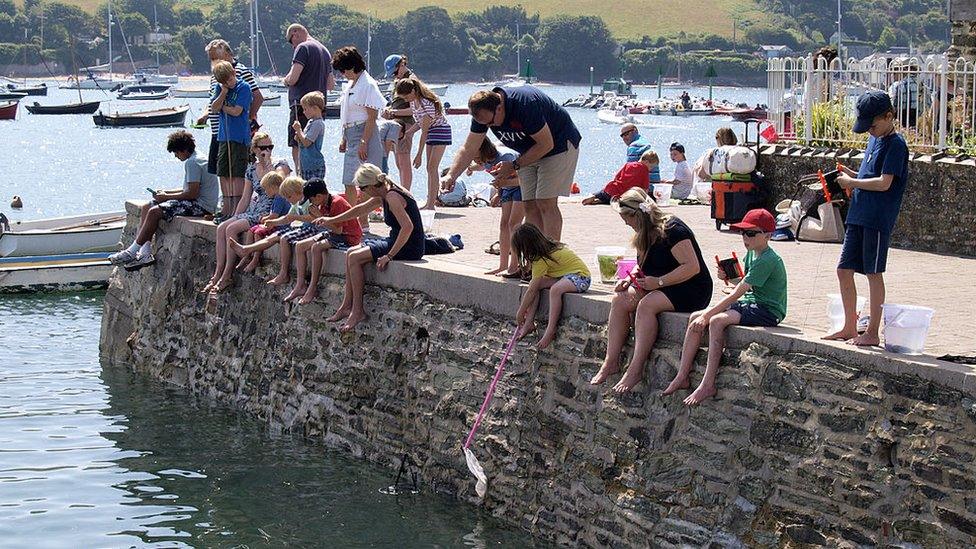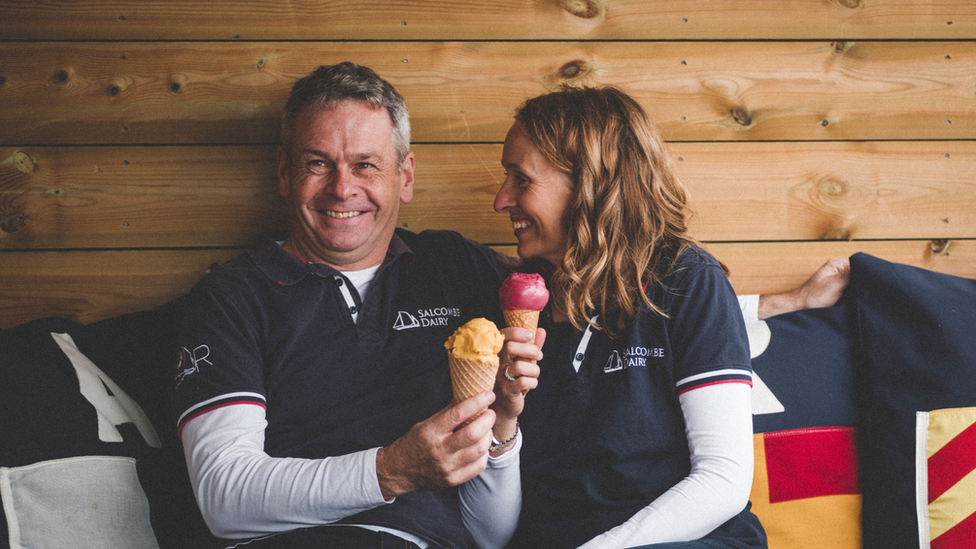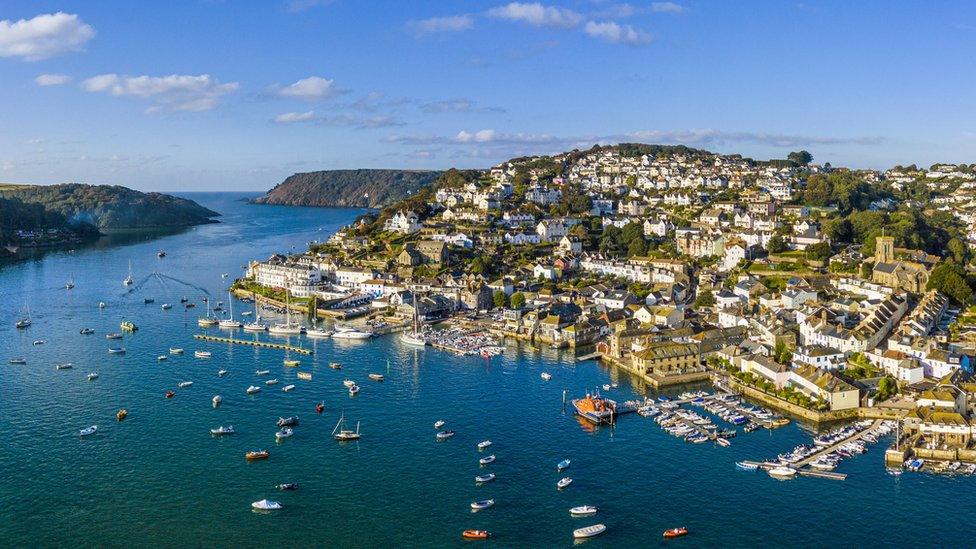Salcombe: What's it like living in the UK's most expensive seaside town?
- Published

Sam Long says there is nowhere better to work on boats
"I was one of the holidaymakers who made it my home," says Sam Long, who moved to Salcombe in 2009. Fourteen years later he has no regrets.
Salcombe, in south Devon, has been named Britain's most expensive seaside town, with an average house price of more than £1.2m, according to Halifax.
The picture-postcard scenery speaks for itself - but its popularity comes with a cost. Rising house prices make it unaffordable for many locals, and outside of tourist season, lots of the homes are empty. So what's it actually like to live there?
Anyone who has lived or worked in Salcombe knows that the summer flood of tourists - and the accompanying struggle to finding a parking space - is now the norm. Walking down the high street in August can be like tackling an obstacle course.
When the sun shines, families hurry around in search of ice cream, cars squeeze past pedestrians on narrow lanes and people dodge greedy seagulls that are eager to snap up any pasty left briefly unattended.
The buzzing atmosphere, seaside views and (mostly) friendly "grockles", or holidaymakers, make it all worthwhile for many people - while spotting celebs is an added perk.
"It's beautiful and absolutely the most stunning place I'd ever been to," says Sam, who grew up in London. "I fell in love as a kid and constantly begged my parents to move here," he says.
As a child, being able to walk down to the local bakery for bread on your own was a freeing treat, he says - and a change from his life back in London.

Sam, who moved to Salcombe after university, runs Devon Boat Sales and Salcombe Sea School, and asks: "Where else would you rather be if you work with boats?"
There is a "great local community here which I think people forget", he says. He has volunteered for the Royal National Lifeboat Institution, is involved with the rugby club, and every year he helps other local residents put the town's Christmas lights up.
"Everyone looks after everyone and I feel very safe and happy bringing my kids up here," he says.

The estuary is arguably the focal point of the town. During the peak season the wall at Victoria Quay is full of crabbers competing to fill their buckets, boat users battling for water space and teenagers jumping off the wall at high tide.
Walking round the corner, to Fore Street, you come across one of Salcombe's many ice cream shops.
Lucia Bly, the co-owner of Salcombe Dairy, says that working in the shop is "relentless" as "generations of holidaymakers come back for an ice cream on the beach".

Lucia, who co-owns Salcombe Dairy with her husband Dan, says you have to be creative to make a business work in the town
Salcombe Dairy is near a park-and-ride drop off, which is a life-saver for many because the town's few car parks often resemble the Boxing Day sales.
Lucia, who owns the business with her husband Dan, says they love that people come on holiday here - "but it would be better if they didn't all come at once".
For a few years, the ice-cream shop thrived in the summer but then lost money in the winter.
Lucia says it is still "very hard" in winter, but that the business has adapted to keep its staff employed all year round, such as by stocking other products and selling ice cream online for delivery around the country.
She says she'd like more of the revenue Salcombe generates in the summer to be used to help locals, and suggests improving the roads and a cycle path into the town.

Further down the narrow street, tourists step in and out of the independent cafes, sandwiched between high street names such as Joules and Fat Face.
Then passing Whitestrand car park, which sees ferries pick up visitors to take them to local beaches, a key feature of Salcombe emerges - one of its many hills.
The town consists of steep winding roads climbing up the cliffside, connecting the more tourist-heavy area of Salcombe near the water with the more lived-in section at the top of the hill.
As well as the primary school and the rugby club at the top of the hill, Salcombe also has two churches and one supermarket.
They're sustained by a local population of about 2,000, compared to the roughly 25,000 people who come in the summer, says estate agent Theo Spink, a resident for the past 10 years.
Tourists are essentially the "lifeblood" of the town, she says - and Salcombe has a similar second-homeowner problem to many seaside towns.
"I think 75% of the houses are not lived in."

Estate agent Theo Spink says 75% of the houses in Salcombe "are not lived in"
This week, local councillor Julian Brazil, told the Guardian that some key workers such as nurses, teachers, care workers and cleaners could no longer afford to live in the area,
"In the winter, in February, you'll look across at Salcombe, and there aren't any lights on," he said.
Theo says it can be a "struggle" to find properties for local people because of "the influx of holidaymakers pushing prices up".
It's a "big problem", she says, and people have to compromise to get what they want or move to comparatively cheaper towns nearby, such as Malborough.
Sam acknowledges that in the winter you can "walk from one end of the High Street to the other and not see anyone".
"But if you want to live here it's part of the parcel," he says.

Current listings on Luscombe Maye's website show properties ranging from £2.6m for a two-bed penthouse to £350,000 for a one-bedroom flat.
And a local rental property website suggests renting a house for four people for a week can cost more than £1,200.
But despite high prices, and famous faces being spotted throughout the town over the years, it still feels like home to many people.
Theo says it's still a "bucket-and-spade type place" with no Michelin star restaurant and not many hotels.
The town is still "about being in a little boat in the rain in your wellies", she says.
Related topics
- Published5 April 2023

- Published14 January 2022
